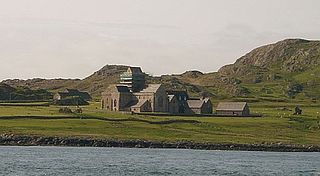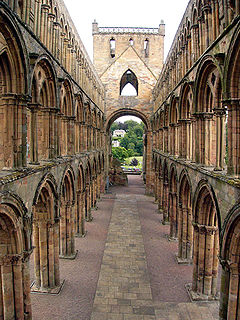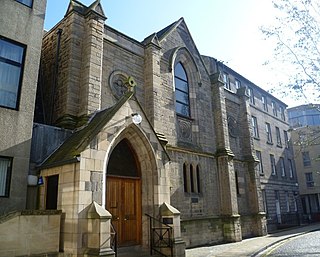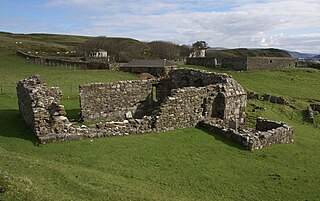
Iona is a small island in the Inner Hebrides, off the Ross of Mull on the western coast of Scotland. It is mainly known for Iona Abbey, though there are other buildings on the island. Iona Abbey was a centre of Gaelic monasticism for three centuries and is today known for its relative tranquility and natural environment. It is a tourist destination and a place for spiritual retreats. Its modern Scottish Gaelic name means "Iona of (Saint) Columba".

Tobermory is the capital of, and until 1973 the only burgh on, the Isle of Mull in the Scottish Inner Hebrides. It is located on the east coast of Mishnish, the most northerly part of the island, near the northern entrance of the Sound of Mull. The village was founded as a fishing port in 1788; its layout was based on the designs of Dumfriesshire engineer Thomas Telford. It has a current population of about 1,000.

Brechin is a town and former Royal burgh in Angus, Scotland. Traditionally Brechin was described as a city because of its cathedral and its status as the seat of a pre-Reformation Roman Catholic diocese, but that status has not been officially recognised in the modern era. Nevertheless, the designation is often used, with examples being the City of Brechin and District Community Council, City of Brechin and Area Partnership, City of Brechin Civic Trust and Brechin City Football Club. Kinnaird Castle is nearby. Brechin is located slightly closer to Dundee than Aberdeen and is located on the A90 between the cities. It is the fourth largest settlement of Angus.

The Isle of Mull or just Mull is the second-largest island of the Inner Hebrides and lies off the west coast of Scotland in the council area of Argyll and Bute.

Kintyre is a peninsula in western Scotland, in the southwest of Argyll and Bute. The peninsula stretches about 30 miles, from the Mull of Kintyre in the south to East and West Loch Tarbert in the north. The region immediately north of Kintyre is known as Knapdale.

Bunessan is a small village on the Ross of Mull in the south-west of the Isle of Mull, off the west coast of Scotland. The settlement is within the parish of Kilfinichen and Kilvickeon, and is situated on the A849.
The Dean of the Chapel Royal, in any kingdom, can be the title of an official charged with oversight of that kingdom's chapel royal, the ecclesiastical establishment which is part of the royal household and ministers to it.

David BryceFRSE FRIBA RSA was a Scottish architect.

Lochbuie is a settlement on the Isle of Mull in Scotland about 22 kilometres (14 mi) west of Craignure.

Eileach an Naoimh, also known as Holy Isle, is an uninhabited island in the Inner Hebrides of the west coast of Scotland. It is the southernmost of the Garvellachs archipelago and lies in the Firth of Lorne between Mull and Argyll. The name is Gaelic for "rocky place of the saint".

The Church of Scotland offices are located in the centre of Edinburgh, Scotland at 121 George Street. These imposing buildings are popularly known in Church circles as "one-two-one". They were designed in a Scandinavian-influenced style by the architect Sydney Mitchell and built in 1909-1911 for the United Free Church of Scotland. Following the union of the Church of Scotland and the United Free Church of Scotland in 1929 the church offices were henceforth used by the newly united church.

Salen is a settlement on the Isle of Mull, Scotland. It is on the east coast of the island, on the Sound of Mull, approximately halfway between Craignure and Tobermory. The full name of the settlement is 'Sàilean Dubh Chaluim Chille'. In 1991 it had a population of 500.

Tobermory High School is the only secondary school on the Isle of Mull. It is located in Tobermory, at the northern end of the island.

A Qualified Chapel, in eighteenth and nineteenth century Scotland, was an Episcopal congregation that worshipped liturgically but accepted the Hanoverian monarchy and thereby "qualified" under the Scottish Episcopalians Act 1711 for exemption from the penal laws against the Episcopal Church of Scotland.

The Garrison Church is a church at Sankt Annæ Plads in Copenhagen, Denmark. The Baroque church was erected as a church primarily intended for military personnel stationed in the city.

Church architecture in Scotland incorporates all church building within the modern borders of Scotland, from the earliest Christian structures in the sixth century until the present day. The early Christian churches for which there is evidence are basic masonry-built constructions on the west coast and islands. As Christianity spread, local churches tended to remain much simpler than their English counterparts. By the eighth century more sophisticated ashlar block-built buildings began to be constructed. From the eleventh century, there were larger and more ornate Romanesque buildings, as with Dunfermline Abbey and St Magnus Cathedral in Orkney. From the twelfth century the introduction of new monastic orders led to a boom in ecclesiastical building, often using English and Continental forms. From the thirteenth century elements of the European Gothic style began to appear in Scotland, culminating in buildings such as Glasgow Cathedral and the rebuilt Melrose Abbey. Renaissance influences can be seen in a move to a low-massive style that was probably influenced by contacts with Italy and the Netherlands.

Scottish religion in the nineteenth century includes all forms of religious organisation and belief in Scotland in the 19th century. This period saw a reaction to the population growth and urbanisation of the Industrial Revolution that had undermined traditional parochial structures and religious loyalties. The established Church of Scotland reacted with a programme of church building from the 1820s. Beginning in 1834 the "Ten Years' Conflict" ended in a schism from the established Church of Scotland led by Dr Thomas Chalmers known as the Great Disruption of 1843. Roughly a third of the clergy, mainly from the North and Highlands, formed the separate Free Church of Scotland. The evangelical Free Church and other secessionist churches grew rapidly in the Highlands and Islands and urban centres. There were further schisms and divisions, particularly between those who attempted to maintain the principles of Calvinism and those that took a more personal and flexible view of salvation. However, there were also mergers that cumulated in the creation of a United Free Church in 1900 that incorporated most of the secessionist churches.

The King Khalid Building is an event space in the Southside, Edinburgh, Scotland, owned and operated by the Royal College of Surgeons of Edinburgh. The building was constructed Roxburgh Free Church in 1847 and converted to its current use in 1982.

St. Kenneth's Chapel is a ruined chapel on Inch Kenneth Island, Parish of Kilfinichen and Kilvickeon, Isle of Mull, Argyll and Bute, Scotland. It dates to the 13th century. It became a Scheduled Monument on 27 March 1928.

St Andrew's Orthodox Church is an Orthodox church located in the Southside, Edinburgh, Scotland. Edinburgh’s Orthodox community was founded in 1948 and has, since 2013, occupied the former Buccleuch Parish Church, which was founded as a chapel of ease of St Cuthbert's in 1756 and closed in 1969.



















